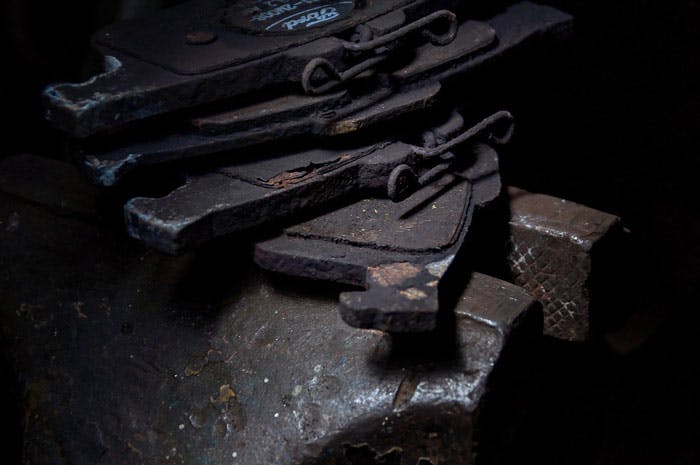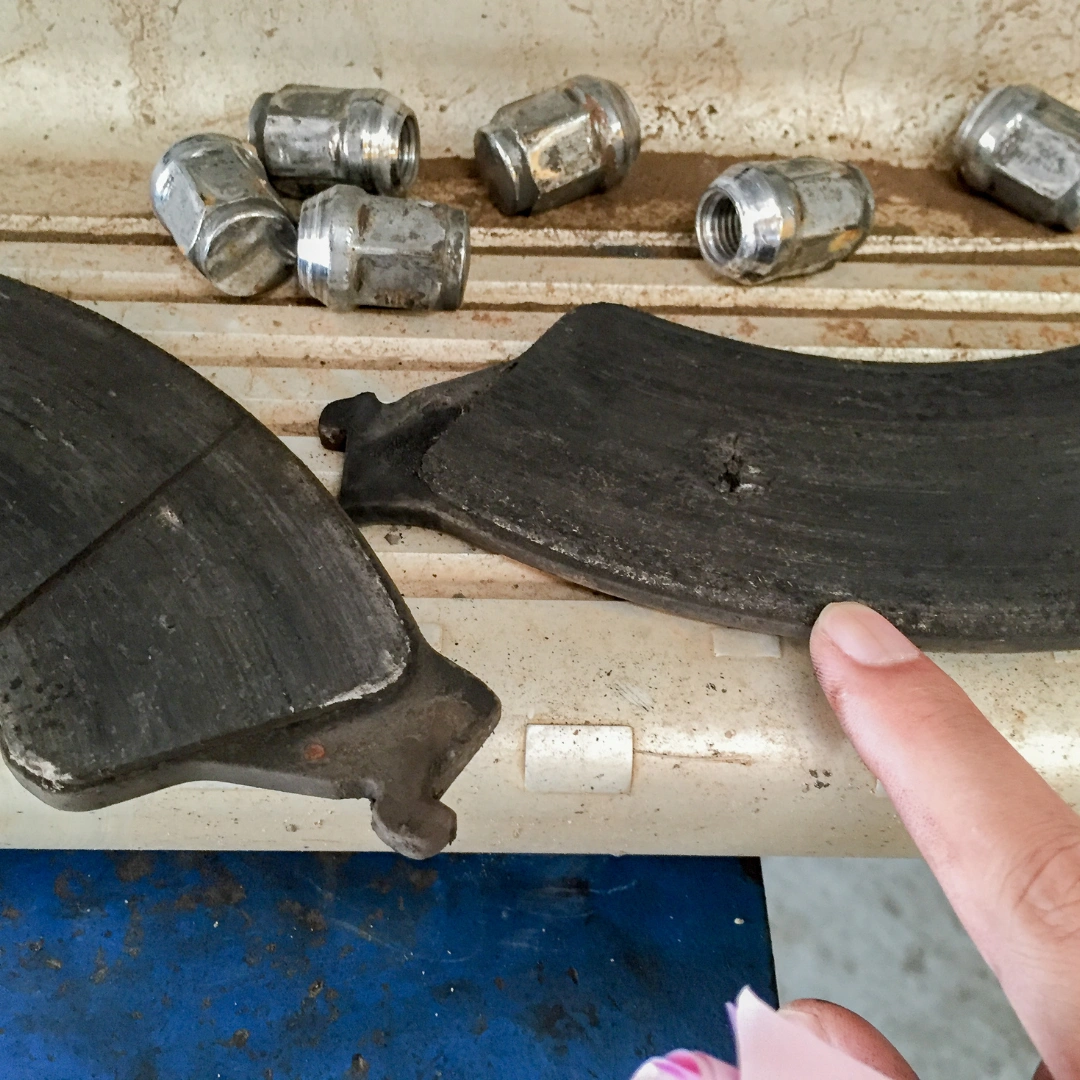On average, brake pads should be replaced every 25,000 to 65,000 miles, while rotors typically last anywhere from 30,000 to 70,000 miles.
The exact lifespan of your brake pads and rotors will depend on a combination of factors, like the conditions you drive in, your personal driving style, and the quality and composition of your pads and rotors. Fortunately, a few different signals can alert you to a brake system issue, including noises or vibrations coming from your brakes or noticeably longer stopping times.
If you do need new brakes, costs for brake pad replacement are generally going to be between $150 and $300, with pads and rotors together costing anywhere from $300 to $600 or more.
What you pay will ultimately depend on your vehicle, the brand and type of brake components you prefer, and where you take your brakes to be serviced.
Key Takeaways:
|
What determines how often you need to replace your brake pads and rotors?
While several factors influence how often you need to replace your brake pads and rotor, some of the key factors include how you drive and where, as well as the quality and compositions of your brake components.
Driving Conditions
One significant factor in the lifespan of your brake pads is where you live and drive. If most of your drive time is spent amid the constant stop-and-go of city traffic, you're going to have to replace your brake pads a lot more often than someone who spends most of their commute traveling down the highway. City driving puts more strain on your brakes due to braking frequency, whereas highway driving typically needs significantly less use of your brake system.
Driving Style
If you're more aggressive behind the wheel, chances are you're braking harder and more frequently than someone who lives for better gas mileage. The high heat from aggressive or frequent braking can cause brake pads to melt onto the brake rotor, reducing the life of the brake pads and rotors. It can also cause a condition called glazing when the excess heat causes the brake pad's surface to harden.
The surface becomes smooth and glasslike, reducing the pad’s ability to generate friction against the rotor. If your driving style has you slamming on the brakes with any kind of regularity, you may need to replace your brakes pretty frequently.
Brake Pad and Rotor Composition
How often you need to replace your brake pads and rotors has a lot to do with their material composition and how well they are made.
Three types of brake pads
When it comes to brake pads, there are three different types to choose from: Organic, semi-metallic, and ceramic. The type of brake pads you choose for your vehicle will greatly influence when they will need to be replaced.
Organic brake pads. Organic brake pads are by far the least expensive option on the market. Made of materials like rubber, glass, and Kevlar mixed with various resins, this type of pad produces a large amount of brake dust. Because they can’t take as much heat, they also wear down more quickly than either metallic or ceramic brake pads. Unless you do very little driving, you will probably need to change organic brake pads more frequently, which may cut into the savings you get from opting for a less expensive brake pad.
Semi-metallic brake pads. As an alternative to organic brake pads, semi-metallic pads offer superior stopping power at a slightly higher price point. Built for performance, this type of pad is particularly useful if you drive for fun or need to haul heavier loads with your vehicle. Given their 30%-65% metallic composition, they are also the noisiest of the three. While more durable than organic brake pads, and able to withstand intense heat, semi-metallic brake pads are also harder on your rotors and the brake system overall. Even so, if you want incredible braking performance with the ability to stop on a dime, this pad is it.
Ceramic brake pads. Finally, ceramic brake pads provide excellent braking power and tend to last longer than either their semi-metallic or organic alternatives. They are incredibly effective at dispersing heat and produce little in the way of noise and dust. If you want pads that are reliable and can last a long time even with a lengthy commute, then ceramic pads are probably your best bet.
Rotor quality and metallurgy
Made of cast iron mixed with other elements like carbon, graphite, and pearlite, rotors are designed to withstand friction and dissipate heat. However, like brake pads, brake rotors wear down a bit every time you apply the brakes.
Not long ago, you could rely on rotors to last through two or three brake pad replacements. However, many newer brake rotors are designed around fuel economy, resulting in a light, thinner, less durable design. Depending on the rotors originally installed in your vehicle, they will need to be replaced right along with your first new set of brake pads.
In some instances, a brake shop will offer to resurface or “turn” your rotors as an alternative to replacement. This process involves using a machine to shave off the uneven parts of the rotor so that your new brake pads will be hitting a smooth surface.
While machined rotors may give you a few thousand extra miles of use, you will usually end up back in the shop having them replaced before your new pads wear out (in which case you’ll probably need to get a whole new set of pads as well).
Therefore, consider the pros and cons before resurfacing your rotors. It may be less costly down the road to replace everything at once if your brake rotors show signs of wear.
How To Tell If Your Brake Pads and Rotors Need to Be Replaced
Now that you know what determines how often you need to replace your brake pads and rotors, here are some signs of wear and tear that indicate you need to replace them:
-
Noise: If you hear grinding, screeching, squealing, rubbing, or other high-pitched noises from your brakes, it's a sign that your brake pads are worn down and must be replaced.
-
Vibration or Pulsing: If you feel vibration or pulsing while stopping, it indicates that your brake rotors are warped and need to be replaced.
-
Longer Stopping Time: If your vehicle takes longer to stop than usual, it's a sign that your brake pads are worn down and need to be replaced.
-
Burning Smell: If you smell a burning odor from your brakes, it's a sign that your brake pads are overheating due to excessive use and need to be replaced.
-
Brake Warning Light: If your brake warning light is on, it indicates an issue with your brake system, and you need to have it checked by a professional.
-
Thin Brake Pads: If your brake pads are thinner than ¼ inch or 6.4mm, it's time to replace them.
-
Worn Brake Rotors: If your brake rotors are worn beyond the minimum discard thickness set by the manufacturer, it's time to replace them. You may also notice tangible grooves, ridges, or rust on your brake rotors, indicating they need replacement.





